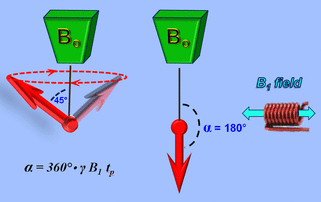Flip angle, also called tip angle, is the amount of rotation the net magnetization (M) experiences during application of a radiofrequency (RF) pulse. It is often designated by the Greek letter alpha (α) and can be measured in degrees (°) or radians (R). For conversion 360° = 2π radians.
For a strong and rectangular RF-pulse of constant amplitude (B1) and duration (tp), the resultant flip angle (α) is approximately
For a strong and rectangular RF-pulse of constant amplitude (B1) and duration (tp), the resultant flip angle (α) is approximately
α = γ • B1 • tp
If γ is expressed in MHz/T, then multiplying the above result by 360°/cycle will give α in degrees.
|
Here is a solved problem that may help show how these equations may be used:
Question: Suppose we are performing conventional ¹H MRI in a scanner where the B1 field has magnitude of 2μT. How long should this RF field be applied to flip M by 180°? |
In reality actual flip angle across an image is not uniform or quite so simple to calculate. It is affected significantly by the radiofrequency pulse shape used (e.g., Gaussian, sinc, truncated-sinc), as well as slice-selection gradients, off-resonance excitations, and Bo field inhomogeneities. These effects become particularly problematic as field strengths are increased to 3.0T and above.
Advanced Discussion (show/hide)»
The above equation for excitation flip angle is valid only in for pure rectangular pulses with relatively small angles (α<30°) and for spins close to the central resonance frequency of the RF-pulse. The equation falls apart for angles much greater than 90° where the Bloch equations behave non-linearly.
In general, α = 360º•γ•∫tpB1(t)dt
References
Wang J, Mao W, Qiu M et al. Factors influencing flip angle mapping in MRI: RF-pulse shape, slice-select gradients, off-resonance excitation, and Bo inhomogeneities. Magn Reson Med 2006; 56(2):463-468.
Wang J, Mao W, Qiu M et al. Factors influencing flip angle mapping in MRI: RF-pulse shape, slice-select gradients, off-resonance excitation, and Bo inhomogeneities. Magn Reson Med 2006; 56(2):463-468.

